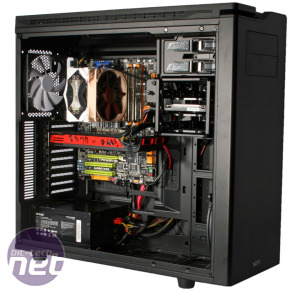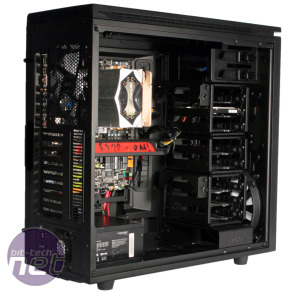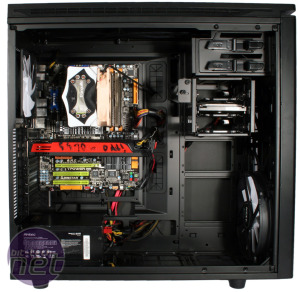
Performance Analysis
The H630 is a quiet case, and is certainly a little less noisy than the Fractal Design Define XL R2 on full speed, but it's still some way off the Define R4 and Nanoxia's Deep Silence cases when it comes to noise production. It isn't helped by the fact that its fans can only be set to full speed. While the 200mm fan benefits from being so large, the 140mm rear fan is particularly audible, so it seems NZXT's fans could do with some work. That said, the noise of our own hardware inside the chassis is contained fairly well.During thermal testing, our CPU reaches a delta T of 54°C. This isn't a dreadful result, but it's a little disappointing considering the noise that the rear fan emits. Similar cases from NZXT such as the Phantom 630 and Phantom 820, are also both able to better this result, even at minimum speed, no doubt benefiting from the 200mm roof extraction fan they both feature.
On the other hand, the GPU stabilises at a delta T result of 50°C. Again this isn't an especially exciting result, with other cases able to achieve similar with minimum speed fans, but it is an understandable one given the lack of side ventilation (and as we said, the case does contain the sound of the card well). There's also a limited supply of air to the front fan thanks to minimal front ventilation and, in fact, regardless of whether we kept the front drive cages installed or not, the results stayed the same. Thus, while the front fan might not make too much difference to temperatures, it's at least quiet and does keep things under control.
Conclusion
Even if we give NZXT the benefit of the doubt when it comes to fixing the high tension in the front panel retention clips, the overall feeling we're left with is that the H630 is a very good case that just misses the mark, and misses some opportunities, in a few too many places. On the plus side, little touches like the hinged side panels, SD reader and I/O lights are indicative of sensible design choices, and ones we wish to see more of in the market. The solid steel exterior and cable routing options are also excellent, as is the case's water-cooling potential.

Click to enlarge - Testing with the drive cage in and out made no difference to the recorded temperatures
Two areas where we feel the case needs work, however, are the fans and the drive cages. For £120 we don't think it unreasonable to expect a third fan and/or fan control. The lack of the latter is particularly irksome as any fans you add to the case will automatically run at full speed, which strongly contradicts its low noise principle; the included fan hub is just begging to be hooked up to some sort of input voltage regulation. As for the drive cages, it's not just the plastic trays that are disappointing. While the case has two extra drive bays compared to the Phantom 630, it's lost the flexibility of their arrangement as well as the ability to move the cages further back into the case; a strange choice given the numerous water-cooling options at the front.
We're sure the H630 will sell well thanks to a strong marketing push and its attractive aesthetics and feature set, and we have no gripes with that as it is a lovely bit of kit. It easily has the upper hand on the Define XL R2 in terms of water-cooling, but Fractal's case can perform quieter and is at least £20 cheaper and thus a solid alternative. Unless you need the space these two cases offer, the Nanoxia Deep Silence 1 and Fractal Define R4 are still the low noise champions, however. Nevertheless, the H630 is mostly well priced for what it offers, and as a few changes in some key areas are all that's required to push this chassis from greatness to excellence, we look forward to seeing what NZXT does next with it.
-
Value17 / 20
-
Design27 / 30
-
Features18 / 20
-
Cooling17 / 30


MSI MPG Velox 100R Chassis Review
October 14 2021 | 15:04










Want to comment? Please log in.